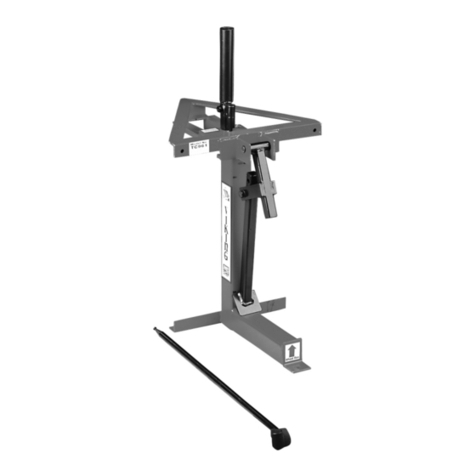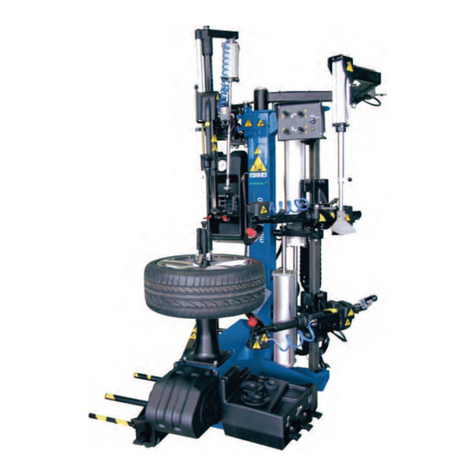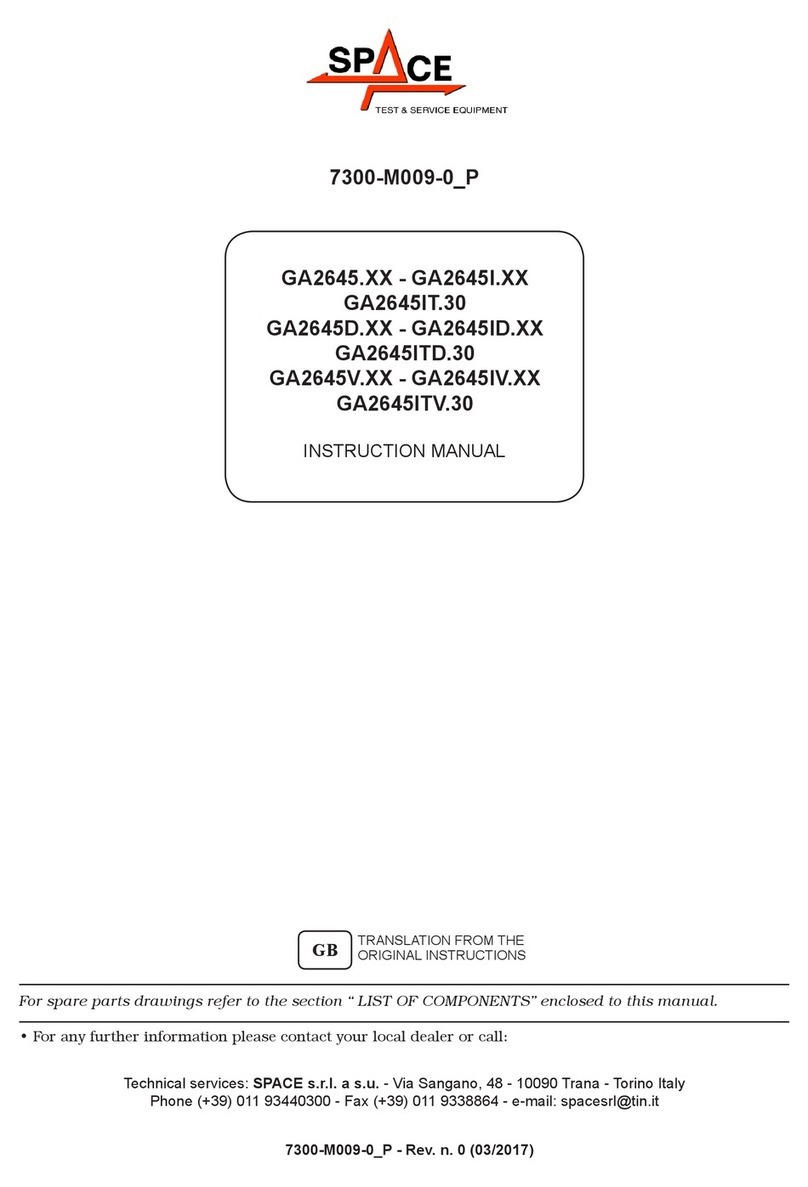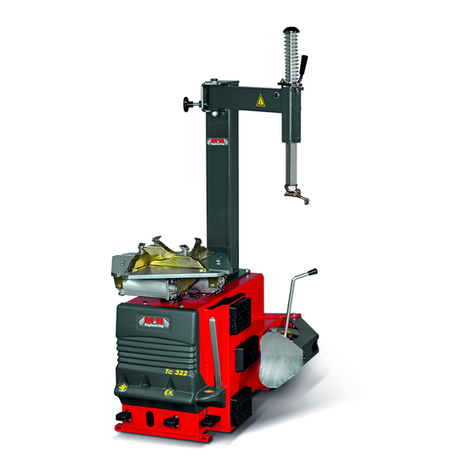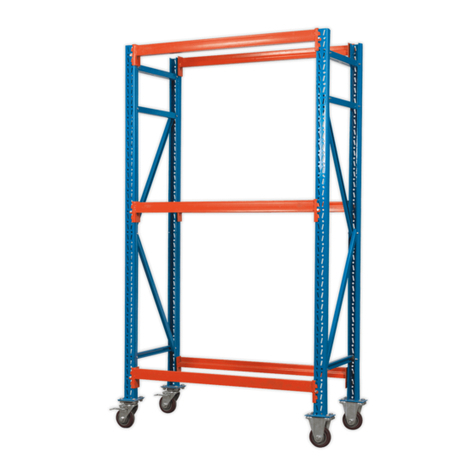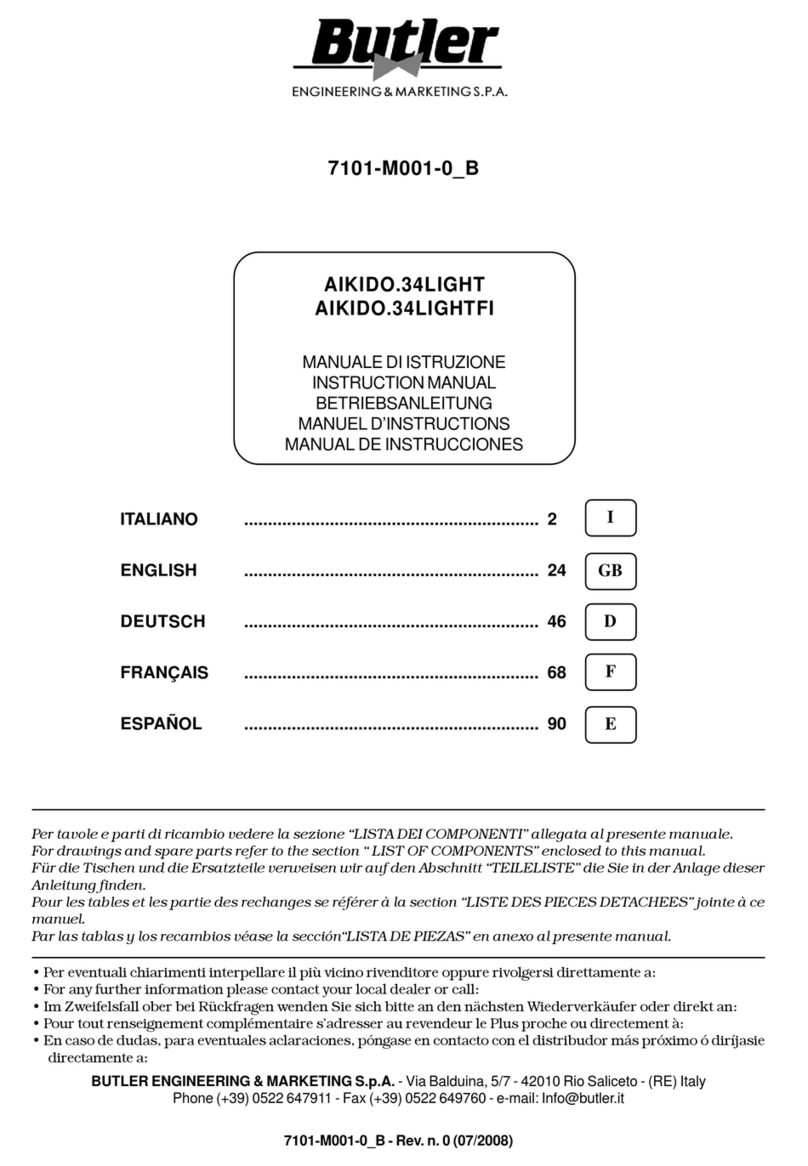Michelin XRV Operating instructions

MICHELIN®RV Tires
• Guide or Proper Use
and Maintenance
• RV Tire Information

MICHELIN®RV Tires
TAB E OF CONTENTS
eneral Information About MICHELIN®RV Tires .........................................................................................................1
Service Life for RV/Motorhome Tires..............................................................................................................1
The Importance of Tire Pressure.....................................................................................................................1
Pressure Requirement......................................................................................................................................2
When to Check RV Tire Pressure.....................................................................................................................2
Determining the RV’s Correct Weight............................................................................................................2
How to Weigh the Recreational Vehicle ......................................................................................................................3
How To Weigh the RV .....................................................................................................................................3
Three Different Types of Scales ......................................................................................................................3
Weighing the Single Axle Recreational Vehicle ............................................................................................4
Weighing the Tandem Axle Recreational Vehicle .........................................................................................5
The Effect of Towed Vehicles or Trailers ........................................................................................................5
How to Use the Actual RV Weight Information with the Tire Data Load Chart ........................................6
Using Blocks to Level Motorhomes and RVs Equipped with Radial Tires....................................................6
Maintaining MICHELIN®RV Tires...................................................................................................................................7
Aging, Weather Checking, and Ozone Cracking...........................................................................................7
Long Term Storage of RV Tires .......................................................................................................................7
Proper Cleaning of RV Tires ............................................................................................................................7
Tire Repair ........................................................................................................................................................7
Tire Inspection..................................................................................................................................................7
Common Tire Damages..................................................................................................................................................8
Underinflation .................................................................................................................................................8
Fatigue Rupture ...............................................................................................................................................8
Dual Kissing......................................................................................................................................................8
Tire Wear, Balance, and Wheel Alignment — Toe Wear, Camber Wear, Tire Rotation ............................................9
Vibration Diagnosis......................................................................................................................................................10
Vibration Complaint ......................................................................................................................................10
Vibration Diagnosis .......................................................................................................................................10
Selecting Replacement Tires for the RV .....................................................................................................................10
MICHELIN®RV Tire Reference Chart............................................................................................................................11
MICHELIN®XRV®.............................................................................................................................................12
MICHELIN®XZA®(10R17.5) ............................................................................................................................12
MICHELIN®XPS RIB®.......................................................................................................................................13
MICHELIN®XZA3®+ EVERTREAD....................................................................................................................14
MICHELIN®XZA®(365/70R22.5) .....................................................................................................................14
MICHELIN®XZA2®ENER Y ............................................................................................................................15
MICHELIN®XZA®1...........................................................................................................................................15
MICHELIN®XZE®2+ .........................................................................................................................................16
MICHELIN®XZE®2............................................................................................................................................16
MICHELIN®XZE®..............................................................................................................................................17
Michelin Inflation Charts for RV Usage Only ............................................................................................................18
Wheel Diameter 16"......................................................................................................................................18
Wheel Diameter 17.5"...................................................................................................................................18
Wheel Diameter 19.5"...................................................................................................................................18
Wheel Diameter 22.5"...................................................................................................................................19
Wheel Diameter 24.5"...................................................................................................................................20
RV Front Axle Overload ...............................................................................................................................................21

SERVICE IFE FOR RV/MOTORHOME
TIRES
The following recommendation applies to
RV/Motorhome tires. Tires are composed of various types
of material and rubber compounds, having performance
properties essential to the proper functioning of the tire
itself. These component properties evolve over time.
For each tire, this evolution depends upon many factors
such as weather, storage conditions, and conditions of
use (load, speed, inflation pressure, maintenance, etc.)
to which the tire is subjected throughout its life. This
service-related evolution varies widely so that accurately
predicting the serviceable life of any specific tire in
advance is not possible.
That is why, in addition to regular inspections and
inflation pressure maintenance by consumers, it is
recommended to have RV/Motorhome tires, including
spare tires, inspected regularly by a qualified tire
specialist, such as a tire dealer, who will assess the
tire’s suitability for continued service. Tires that have
been in use for 5 years or more should continue to be
inspected by a specialist at least annually.
Consumers are strongly encouraged to be aware not
only of their tires’ visual conditions and inflation
pressures, but also of any changes in dynamic
performances such as increased gas loss, noise, or
vibration, which could be an indication that the tires need
to be removed from service to prevent tire failure. It is
impossible to predict when tires should be replaced based
on their calendar age alone. owever, the older a tire, the
greater the chance that it will need to be replaced due to
the service-related evolution or other conditions found
upon inspection or detected during use.
While most tires will need replacement before they
achieve 10 years, it is recommended that any tires in
service 10 years or more from the date of manufacture,
including spare tires, be replaced with new tires as a
simple precaution even if such tires appear serviceable
and even if they have not reached the legal wear limit.
For tires that were on an original equipment vehicle
(i.e. acquired by the consumer on a new vehicle), follow
the vehicle manufacturer’s tire replacement
recommendations when specified (but not to exceed
10 years).
The date when a tire was manufactured is located on
the sidewall of each tire. RV owners should locate the
Department of Transportation or DOT code on the tire
that begins with DOT and ends with the week and year
of manufacture. For example, a DOT code ending with
“0304” indicates a tire made in the 3rd week (Jan) of 2004.
THE IMPORTANCE OF TIRE PRESSURE
The most important factor in maintaining the life of
MIC ELIN®RV tires is making sure they are always
properly inflated. Incorrect pressure for the weight
of the vehicle is dangerous and could cause things like
premature wear, tire damage, or a harsher ride.
An underinflated or overloaded tire will build up more
heat that could go beyond the endurance limits of the
rubber and radial cords. This could cause sudden tire
failure. Underinflation will also cause poor handling,
faster and/or irregular tire wear, and can decrease fuel
economy.
Overinflation, on the other hand, will reduce the tire’s
contact area with the road, which reduces traction,
braking ability, and handling. A tire that’s overinflated
for the weight it’s carrying is more prone to a harsh ride,
uneven tire wear, and impact damage.
MICHELIN®RV Tires 1
DOT
Plant
Tire Size
Optional Code
MICHE IN
Manufacture
Date
GENERA INFORMATION ABOUT MICHE IN®RV TIRES

2MICHELIN®RV Tires
PRESSURE REQUIREMENT
The amount of pressure required in each tire depends
on the weight of the fully loaded vehicle. So the RV
owners cannot determine the tire’s correct pressure
unless they know their vehicle’s actual weights. The
maximum load capacity allowed for the size tire and load
rating and the minimum cold inflation pressure needed
to carry that maximum load are located on the tire’s
sidewall. The lower the pressure, the lower the load that
the tire can carry. A complete load and inflation table is
available at www.michelinrvtires.com; MIC ELIN®RV
Tires: Guide For Proper Use and Maintenance and RV Tire
Information – MWL43146; and the MIC ELIN®Truck Tire
Data Book – MWL40731.
WHEN TO CHECK RV TIRE PRESSURE
The RV owners need to know the correct pressure per
axle for their RV, and they need to know when and how
often to check the MIC ELIN®RV tires.
ere are a few recommendations for the RV owners:
1) Check at least once a month and before any major
trips.
2) On long trips, check every morning before driving.
3) Check before and after storage.
4) On short trips of a day or less driving each way,
check before you leave and before you return home.
Always try to check tires when they’re “cold” and have
not been driven for more than one mile. The stated load
capacity for a given cold inflation pressure is based on
ambient outside temperatures. The pressure in a “hot”
tire may be as much as 10-15 psi higher than the “cold”
tire pressure. If the RV owners must check the tires when
they’re warm, be sure to allow for an increase in pressure,
and make sure the pressure of the tires on both sides of
the axle are within a couple of pounds of each other.
Never let gas out of a hot tire.
To make checking the tire pressure easier and more
accurate, Michelin recommends that the RV owners
purchase a quality truck tire pressure gauge with a dual-
angled head. This allows the RV owners to check the
pressure of the inner and outer dual wheels. And the
easier it is to check the pressure, the more that the RV
owner will do it. Nothing should restrict the RV owner’s
ability to check their tire pressure daily when driving their
RV. Be sure to use pressure-sealing valve caps to prevent
gas from escaping the valve stem. If the valve stem
extension hoses are used, make sure they’re good quality
stainless steel braid reinforced and are securely anchored
to the outer wheel. The joints should be soaped
immediately after initial installation to check for pressure
loss. If the RV has wheel covers, consider removing them
since the extra time and effort they require could lead the
RV owners to avoid checking the tire’s pressure.
DETERMINING THE RV’S CORRECT
WEIGHT
The GVWR (Gross Vehicle Weight Rating) and the
GAWR (Gross Axle Weight Rating) stickers on the RV
(normally located on the support pillar next to the driver’s
seat) will show the chassis manufacturer’s and/or the RV
manufacturer’s total vehicle weight ratings and per axle
weight ratings.
The GVWR is the maximum total weight rating — this
includes passengers, fluids, and cargo. The GAWR is the
maximum for a single axle.
These ratings can vary
based on a number of
components, so RVs of the
same make and model will
vary because of different
options and personal loads.
That’s why the RV owners
need to weigh their RV in a
loaded condition to know
its actual weight. Michelin
recommends weighing
each wheel position of the
vehicle. Why? Because
when you weigh the entire
vehicle at once, it’s possible to be within the GVWR, but
overloaded on an axle. And when you weigh one axle at a
time, it’s possible for one wheel position to be overloaded
even though the GAWR has not been exceeded (we’ve
seen as much as a 1200-pound difference between left
and right front tires). Weighing each wheel position will
give you a clear indication of how the weight of the RV
vehicle is distributed, so you can determine the correct
tire inflation pressure.
For instructions on how to weigh by wheel position, see
next pages 3-5. Once you know total weight and weight
on each wheel position, the tire load data chart will show
you the correct inflation pressure for each wheel position.

THREE DIFFERENT TYPES OF SCA ES:
1) Platform – Platform scales are usually long enough to weigh the entire vehicle at once.
Michelin suggests the following:
a) Pull onto the scale so that only the front axle is on the platform. The rear end of the
scale needs to be midway between the front and rear axles. Record the weight.
b) Pull forward until the full unit is on the scale. Record the weight.
c) Pull forward until only the rear axle is on the platform. The front end of the scale needs
to be midway between the front and rear axles. Record the weight.
d) If the RV has a rear tag axle, pull forward so only tag axle is on the scale. Record the
weight.
e) To determine individual wheel position weights, repeat steps (a) through (d) with only
one side of the vehicle actually on the scale and the vehicle centered over the side of
the scale. See diagram on next page. Record the weights.
f) To calculate the opposite wheel positions’ weights, subtract the weights recorded in step
(e) from the weights recorded in steps (a) through (d). If there is not a towed vehicle, the
tag axle weight derived from (d) will represent the actual weight on the tag axle.
g) If a vehicle is being towed, it should be weighed and combined with the GVW (Gross
Vehicle Weight) to ensure the total weight doesn’t exceed the GCWR (Gross Combined
Weight Rating).
2) Segmented Platform – Platform scales with segmented sections can provide individual
axle weights and total vehicle weights all at once when the vehicle is positioned properly.
To do this, simply:
a) Position the vehicle on the scales so that each axle is centered as much as possible on
the segments, and record the weight.
b) Reposition the vehicle so that only one side is on the scale – centered on the segment
as much as possible.
c) Subtract the weighed wheel positions from the total axle weights to determine the
unweighed wheel position weights.
3) Single Axle – Weighs one axle at a time.
Follow these steps:
a) Drive the front axle onto the scale and stop long enough for the weight to be recorded.
b) Pull vehicle forward until the rear axle is on the scale.
c) For gross vehicle weight, add the two axle weights together.
d) To obtain the individual wheel position weights, repeat this process with only one side
of the RV on the scale.
Note: Even though the weight of the total axle is within the axle rating, it may be overloaded on
one side, which means an overloaded wheel position. That’s why side-to-side weighing is
required.
MICHELIN®RV Tires 3
NOTE: Michelin recommends using a professional weighing group or organization to perform the weighing of your
Motorhome/RV. The Recreational Vehicle Safety Foundation (RVSEF) is an organization that performs weighing and other
educational services. They can be contacted at www.rvsafety.com. If you are planning to do your own weighing, you should
follow the procedures below. Michelin recommends checking with the scale operator to make sure there are no concerns on
damage to the scale or to the vehicle if weighing side to side to determine individual wheel position weights.
HOW TO WEIGH THE RV
First, the RV must be weighed fully loaded — that includes passengers, food, clothing, fuel, water, propane, supplies, and
anything else you can think of. Also, any towed vehicle (car, boat, or trailer) or item loaded on brackets on the back of the
RV (like bikes or motorcycles) should be included in the weighing.
SCA E
SCA E
SCA E
HOW TO WEIGH THE RECREATIONA VEHIC E

4MICHELIN®RV Tires
1. From the tire manufacturer’s load and inflation tables or the sidewall of the tires mounted on the vehicle.
2. If vehicle has duals, read dual capacity from tire and multiply by 2 to obtain dual assembly load capacity.
One Side
Scale Weight
Calculate Other
Side Weight
Tire oad (lbs.)
Inflation
__________ lbs. __________ lbs. __________ lbs.
(Step 2a) (Step 2b) (Step 2c)
__________ lbs. __________ lbs. __________ lbs.
(Step 1a-2a) (Step 1b-2b) (Step 1c-2c)
__________ lbs. __________ lbs. __________ lbs.
(See Note #1) (See Notes #1 & #2)
__________ psi __________ psi
(See Note #1) (See Note #1)
STEP 2a STEP 2b STEP 2c
__________ lbs. __________ lbs. __________ lbs. __________ lbs.
(Step 1a = (Step 1b = (Step 1c = (Step 1d)
Gross Axle Weight) Gross Vehicle Weight) Gross Axle Weight)
__________ lbs. __________ lbs. __________ lbs. __________ lbs.
Gross Axle Gross Vehicle Gross Axle Vehicle Weight
Weight Rating Weight Rating Weight Rating (Gross Combined
Weight Rating –
Gross Vehicle Weight)
TO OBTAIN INDIVIDUA AX E AND GROSS VEHIC E WEIGHTS
STEP 1a STEP 1b STEP 1c STEP 1d
Scale Weight
From
Owner’s
Manual
TO OBTAIN INDIVIDUA WHEE POSITION WEIGHTS
The RV must remain as level as possible on the scale (even when an axle or side isn’t on the scale). Therefore, to
obtain side-to-side weights, there must be enough space on either side of the scale to accommodate the RV being
partially off the scale.
If there is a difference in the weights on one side of the vehicle as compared to the other, it is important to
redistribute the load more evenly to avoid component failure and improve handling. These weights make it possible
to compare against the GAWR (Gross Axle Weight Rating), GVWR (Gross Vehicle Weight Rating), and tire capacities.
They also help determine proper tire pressure.
WEIGHING THE SING E AX E RECREATIONA VEHIC E

MICHELIN®RV Tires 5
STEP 2a STEP 2b STEP 2c STEP 2d
(calculated)
STEP 1a STEP 1b STEP 1c STEP 1d STEP 1e
(calculated)
__________ lbs. __________ lbs. __________ lbs. __________ lbs.
(Step 2a) (Step 2b) (Step 2c) Step 2d: Right Duals = (2b-2c)
__________ lbs. __________ lbs. __________ lbs. __________ lbs.
(Step 1a-2a) (Step 1c-2b) (Step 1d-2c) Left Duals = (2d)
__________ lbs. __________ lbs. __________ lbs.
(See Note #1) (See Note #1) (See Notes #1 & #2)
__________ psi __________ psi __________ psi
(See Note #1) (See Note #1) (See Note #1)
__________ lbs. __________ lbs. __________ lbs. __________ lbs. __________ lbs.
(Step 1a = (Step 1b = (Step 1c) (Step 1d = Drive Axle
Gross Axle Weight) Gross Vehicle Weight) Gross Axle Weight) Weight = (1c-1d)
__________ lbs. __________ lbs. __________ lbs. __________ lbs.
Gross Axle Gross Vehicle Gross Axle Gross Axle
Weight Rating Weight Rating Weight Rating Weight Rating
TO OBTAIN INDIVIDUA WHEE POSITION WEIGHTS
Scale
Weight
From
Owner’s
Manual
One Side
Scale Weight
Calculate Other
Side Weight
Tire oad (lbs.)
Inflation
1. From the tire manufacturer’s load and inflation tables or the sidewall of the tires mounted on the vehicle.
2. If vehicle has duals, read dual capacity from tire and multiply by 2 to obtain dual assembly load capacity.
TO OBTAIN INDIVIDUA AX E AND GROSS VEHIC E WEIGHTS
THE EFFECT OF TOWED VEHIC ES OR TRAI ERS
If your RV is towing a vehicle, you need to know the RV’s GCWR (Gross Combined Weight Rating), the total actual
loaded weight of the RV, plus the total actual loaded weight of the towed vehicle. Even though the GCWR has more to
do with the design limits of the drivetrain (engine, transmission, axle, brakes, and bearings), the additional weight can
also affect the tires and the RV’s handling. Also, always remember to consider the tongue weight of the trailer and its
effect on handling.
WEIGHING THE TANDEM AX E RECREATIONA VEHIC E

6MICHELIN®RV Tires
When using blocks to level motorhomes or
RVs, extreme caution must be taken to make
sure the tires are fully supported. The weight
on the tire should be evenly distributed on the
block. And in the case of duals, it should be
evenly distributed on blocks for both tires. If
not, the sidewall cables can become fatigued
and damaged, resulting in a sidewall rupture
and a complete, sudden loss of pressure.
Note in the correct method, the blocks
are wider than the tread and longer than the
tire’s footprint. This provides maximum
support to the tires and assures that the load
is evenly distributed.
Let’s consider an RV running on 275/80R22.5
MIC ELIN®XZA3®+EVERTREAD LRG tires, with actual
corner weights of 5,400 lbs. on the left front tire,
5,175 lbs. on the right front tire, 8,500 lbs. on the left
rear duals, and 9,200 lbs. on the right rear duals. For
control of the RV, it is critical that the tire pressures be
the same across an axle. Therefore, we must “overinflate”
the right front tire and the left rear duals. Checking the
load/inflation table below shows that a cold tire pressure
of 95 psi will support 5,510 lbs. on a single front tire.
To determine the pressure for the rear duals, again
take the heaviest position, in this instance the right rear
weighs 9,200 lbs. The load/inflation table below shows
that a cold pressure of 85 psi will support 9,380 lbs. on
2 dual tires. It is important to note that the cold inflation
pressure for the tire must never exceed the maximum
inflation rating that is stamped on the wheel.
REMEMBER: For control of the RV, it is critical that the
tire pressures are the same on both sides of an axle.
Please note that the standard MIC ELIN
load/inflation charts have been altered for RV usage only.
USING B OCKS TO EVE MOTORHOMES AND RVS EQUIPPED WITH RADIA TIRES
Incorrect
One tire or only a portion of one tire is supporting the full load.
MAXIMUM LOAD
AND PRESSURE ON SIDEWALL
This chart is for RV wheel end use only.
275/80R22.5 RG
PSI 70 75 80 85 90 95 100 105 110
kPa 480 520 550 590 620 660 690 720 760
SIN LE 4500 4725 4940 5155 5370 5510 5780 5980 6175 S 6175 LBS at 110 PSI
DUAL 8190 8600 9080 9380 9770 10140 10520 10880 11350 D 5675 LBS at 110 PSI
SIN LE 2040 2140 2240 2340 2440 2500 2620 2710 2800 S 2800 K at 760 kPa
DUAL 3720 3900 4120 4260 4440 4600 4780 4940 5150 D 2575 K at 760 kPa
LBS
K
S = 1 tire on 1 side of single axle
Single Axle
D = 2 tires on 1 side of dual axle
Dual Axle
For Tag axle, use applicable
Single or Dual chart
Correct
Evenly supporting the full load.
HOW TO USE THE ACTUA RV WEIGHT INFORMATION
WITH THE TIRE DATA OAD CHART

MICHELIN®RV Tires 7
AGING, WEATHER CHECKING, AND
OZONE CRACKING
During the pre-trip inspection, be sure to check the
tires for signs of aging, weather checking, and/or ozone
cracking — these show up as tiny cracks in the rubber
surface on the sidewall of the tire. If the cracks are less
than 1 ⁄32" deep, the tire is fine to run. Between 1⁄ 32" and
2⁄32",the tire is suspect and should be examined by the
MIC ELIN dealer. If the cracks are any deeper than
2⁄32",the tire should be replaced immediately.
ere are a few tips to help you protect the tires from
these common damage conditions:
1) Keep the tires properly inflated.
2) Keep the tires clean.
3) Avoid prolonged exposure to heat, cold, or moisture.
4) Avoid prolonged exposure to ultraviolet rays.
5) Cover the tires when the vehicle is not in use.
6) Do not park near electric generators or transformers.
7) Do not store vehicle in an area where welding is being
done or in a garage that has mercury vapor lamps.
ONG TERM STORAGE OF RV TIRES
Unless the RV owner is a full-time RV-er, the vehicle
probably spends some time in long-term storage. But
what the RV owner probably didn’t know is that rubber
tires age when not being used. So, if the owner must store
the RV, a cool, dry, sealed garage is the best bet. Also, some
storage surfaces can cause tires to age faster. That’s why
Michelin recommends placing a barrier (cardboard,
plastic or plywood) between the tire and the storage
surface.
ere are some other steps the RV owner can take to
help reduce the aging effects from long-term storage:
1) Thoroughly clean tires with soap and water before
placing into storage.
2) Cover tires to block direct sunlight and ultraviolet
rays.
3) Store out of a high ozone area.
Note: When a vehicle is stored, tires should be inflated
to the inflation pressure indicated on the sidewall.
Before removing the vehicle from long-term storage,
thoroughly inspect each tire – this includes sidewalls,
tread area, and pressure. If the tires have lost pressure, be
sure to inflate them to the correct pressure before driving.
PROPER C EANING OF RV TIRES
Like the rest of the RV, it pays to keep the MIC ELIN®
tires clean. Road oil will cause deterioration of the rubber,
and dirt buildup will hold the contaminants next to the tire.
As with the cleaning of any rubber product, proper
cleaning methods must be used to obtain the maximum
years of service from the tires. A soft brush and the
normal mild soap that you would use to clean the RV
may be used. If you use a dressing product to “protect”
the tires from aging, use extra care and caution. Tire
dressings that contain petroleum products, alcohol, or
silicones will cause deterioration or cracking and
accelerate the aging process.
In many cases, it is not the dressing itself that can be
a problem, but rather the chemical reaction that the
product can have with the antioxidant in the tire. eat
can add to the negative reaction. When these same
dressing products are used on a passenger car tire that is
replaced every three to four years, it is rare to see a major
problem. owever, in most cases, RV tires may last much
longer due to limited annual mileage, and the chemical
reactions have much longer to take place.
TIRE REPAIR
Even the best drivers can drive over a nail, and the best
tires can pick up that nail or screw and go flat. If you pick up
an object that causes a flat with a MIC ELIN®RV tire, the
repair must be made to the inside of the tire to be repaired
properly. To do this, the tire needs to be demounted and
inspected on the inside of the casing for any other damage
that the object may have caused. See the MIC ELIN®truck
tire dealer for the proper repair and damage inspection.
TIRE INSPECTION
The MIC ELIN®RV tires should be inspected
thoroughly at least once a year, and any time the owner
drives in rough or rocky terrain, or when the owner is
having their RV serviced. This inspection should include
both sidewalls, the tread area, and the valves, caps, and
any valve extensions. Inspect for nails, cuts, bulges, aging,
or fatigue cracks and weathering or ozone cracking. Also,
check between the duals for objects lodged between
them. See the MIC ELIN®dealer at once if anything
unusual is observed.
On a regular basis, rub the palm of your hand across the
face of the tread on your front tires to feel for any feathered
wear from “toe” alignment problems. NOTE: Be careful
since severe wear can expose steel belt edges that are very
sharp. A “toe” misalignment problem can be caused by
impact with a “chuck” hole in the road. Bad “toe” wear can
be hard to find visually, but can be felt very quickly with the
hand. This type of alignment problem can wear rubber off
the tread of the tires in just a few hundred miles.
MAINTAINING MICHE IN®RV TIRES

No tire, regardless of its quality, is indestructible.
Certain conditions of use and abuse can stress a tire
beyond reasonable operating limits, causing it to come
out of service even when considerable tread remains.
Such conditions are clearly indicated by the damage they
leave on the tire itself. Listed below are some common
damages and the signs they leave behind. Please
understand that this list is by no means exhaustive
and is intended only as a general guide.
UNDERINF ATION
This condition is often referred to as a “run-flat” tire.
It is caused by operating a tire at very low or zero
pressure. When a tire is run at normal highway speeds,
underinflated, it flexes too much and builds up heat.
This heat damages the inner liner, casing, and outer
sidewall of the tire. If not remedied quickly, the tire will
be irreparably damaged.
In extreme cases, the sidewall of the tire is destroyed,
from the excessive heat and the weight of the vehicle
crushing/cutting the tire against the wheel as it rolls on
the uninflated sidewall. According to guidelines put out
by the Rubber Manufacturers Association (RMA), any tire
that has been run at less than 80% of normal
recommended pressure for the load it is carrying should
be inspected for possible damage.
When one tire in a dual configuration comes out of
service due to under-inflation/run-flat damage, the
other tire in the dual configuration should be inspected
immediately. If the unserviceable tire was underinflated,
that means the serviceable tire was carrying more and
more of the load for that wheel position. Consequently,
it too may have suffered some casing damage.
FATIGUE RUPTURE
This type of damage is sometimes called a “zipper rip”
because of the zipper-like effect it creates in the steel
casing cords of the damaged tire. When a casing cord is
damaged or repeatedly and excessively bent due to over-
load and/or underinflation, it will eventually break and
subject the cords on either side to even more stress.
When enough strength has been lost due to additional
cord breakage, a rupture occurs and can progress rapidly
along the path of least resistance in the upper sidewall.
This can happen hours, days, or even months after the
initial damage event when all evidence or memory of the
initial damage or overload/underinflation is gone.
Casing cords in the MIC ELIN®truck tires used on
motorhomes are very strong twisted steel cables.
Extreme over-deflection of a tire, that can occur during
improper blocking of tires or high energy impacts, may
weaken the structure of the cable so as to make it less
tolerant of the repeated bending stress encountered in
normal use. If in addition, the integrity of the steel cords
is degraded by corrosion from moisture reaching the
cords through cuts or tears in the rubber, their tolerance
of these conditions will be even further reduced. This
corrosion may result from mounting damage, foreign
objects left inside the tire, road hazards, tire
mishandling, or even improper repair of a nail hole.
DUA KISSING
While somewhat romantic in name only, this type of
damage refers to what happens when two tires in dual
configuration make contact with each other while in
operation. The heat generated by the friction between
the two tires severely weakens the casing material of the
dual tires. This is easily seen on the sidewalls of the tires
where the duals came in contact. The condition may be
caused by several factors:
- improper mounting
- incorrect wheel width or offset
- underinflation
- “casing growth”
In this last case, the fabric casing cords of the tire
actually stretch and expand, causing the tire to touch
or kiss, under load at the contact patch.
8MICHELIN®RV Tires
Underinflation
Fatigue Rupture or “Zipper”
COMMON TIRE DAMAGES

MICHELIN®RV Tires 9
TIRE WEAR, BA ANCE, AND WHEE
A IGNMENT
All tires mounted on RVs should wear in a smooth,
even wear pattern when the tires are maintained with
the correct pressure for the load on the tire. If tires begin
to show an irregular wear pattern, and the vehicle
alignment is correct, sometimes just rotating the tires
to change direction of rotation and wheel position will
allow the tires to wear evenly.
Significant tire and wheel assembly imbalance may
cause steering difficulties, a bumpy ride, and worn spots
on your tires. It is recommended that tire and wheel
assemblies be inspected and balanced if one of these
conditions exists.
Check with the motorhome chassis manufacturer
for the correct alignment specifications. Michelin
recommends, for optimized radial tire life and
performance, that the “toe-in” setting should be as
close as is practical to zero, within the motorhome
manufacturer’s specifications. The caster should be set
to the maximum positive or minimum negative setting
within the tolerances specified by the manufacturer.
Toe Wear
A feathered wear pattern on the front tires typically
indicates misalignment (toe-in or toe-out). Sometimes
a radial tire will not have this wear pattern unless the toe
condition is severe. Instead of the feathered edge wear,
the tire will be worn on the inside or outside shoulder,
which could be confused with camber wear.
On a three-axle RV, a skewed rear axle and tag could
cause feathered edge wear on one shoulder of one front
tire and feathered edge on the opposite shoulder of the
other front tire. In order to correctly diagnose a tire wear
condition, the motorhome should have the alignment
checked on all wheel positions.
Camber Wear
Also known as edge wear, camber wear shows up on
the inside or outside shoulders of the tread. Wear on the
inside edge of both tires may be due to negative camber
or toe-out, a misalignment. If only one tire shows edge
wear, check for worn kingpin bushings, bent or worn
steering components, or excessive positive camber.
For solid beam axles, excessive camber can result from
axle over-load.
Tire Rotation
If correct pressure and proper alignment are both
continually maintained, tire rotation may never be
needed. owever, in other cases, tire rotation may be
needed to help even out wear patterns caused by
alignment, underinflation, or free-rolling wear problems.
Follow the motorhome manufacturer’s rotation service
recommendations. There are no restrictions as to the
method of rotation with the MIC ELIN®RV tires; however,
Michelin recommends including the spare tire in the
rotation pattern and changing the direction of rotation.
Tires can be rotated front to rear and side to side. If using
directional tires, ensure tires are mounted to rotate in
proper direction as it may contribute to premature wear.
Toe Wear
Toe Wear
Camber Wear
Camber Wear

SE ECTING REP ACEMENT TIRES FOR THE RV
One of the most important RV equipment purchases
that the RV owner will make will be the replacement tires.
If they obtained good service with their first set of tires,
chances are that they were matched well for the RV’s
weight needs and the RV owner type and area of driving.
Should the RV owner choose to replace their tires with
another size, be very careful with this selection. There are
some basic areas of concern, such as the load rating of
the new tire and the overall diameter of the new tire for
vehicle clearance, speedometer reading, and wheel
width.
There is also the matching of the tires to the dual
wheel offset for the dual spacing clearance and the load
rating of the wheel. For example: buying a tire with a
higher load rating that might require 105 psi would be
inappropriate if the RV wheel is limited to 80 psi.
(Be sure that the wheel width is compatible with the
new tire size; doing otherwise is dangerous.) Consult
the vehicle manufacturer for wheel specifications.
If the RV owners have already been driving on
MIC ELIN®RV tires, they are aware of some of Michelin’s
extra benefits, such as the great wet and dry traction and
outstanding handling. Most RV owners who drive on
MIC ELIN®tires for the first time comment on the
smooth, quiet ride.
10 MICHELIN®RV Tires
VIBRATION COMP AINT
When a motorhome owner comes in with a vibration
complaint, contact the appropriate chassis and
motorhome manufacturers to establish an incident
report and get possible motor-home warranty handling
instructions. The following procedure should take care of
most complaints.
1. Driver interview — this should include the following:
– has this vehicle been worked on by the chassis
manufacturer or MIC ELIN®dealer for this
complaint?
– type of complaint
– driving and road conditions when the vibration
occurs - mph/rpm acceleration/deceleration
– when in the life of the vehicle did it begin?
– where does the vibration seem to be coming from?
Front or rear?
– recent maintenance or modifications to the vehicle
2. Vehicle test drive - ride in the vehicle and have the
owner demonstrate the complaint to you to verify
that there is in fact a problem.
Include the following observations:
– speed at onset of vibration and the speed range
– does the vibration phase in and out, or is it
constant?
– sensitivity to road surface? Smooth roads? Rough
roads? Both?
– effects of acceleration/deceleration/constant speed
– is vibration felt through the seat? Floor? Steering
wheel? Other?
– is this a ride quality or a drive train vibration
complaint?
3. Complaint history
– check all motorhome warranty records, etc., to
determine past history of the same or similar
complaints on this vehicle
– have there been any changes or modifications to
the chassis since manufacturing?
– has any prior effort been made to diagnose or
correct the complaint? By whom?
VIBRATION DIAGNOSIS
If the vibration seems to be driveline related and from
the wheel ends, then perform the following:
Tire and wheel assembly inspection
1. Jack up the front of the vehicle and spin each
assembly, observing the wear conditions of each tire
and concentricity of the
tire on wheel mounting.
If the variation in the
distance between the
line-up (“gg”) ring and
the wheel flange exceeds
1⁄16",have the assembly
broken down, relubed,
and remounted (see diagram).
2. Measure and record the radial runout on the vehicle
of each assembly with tire runout gauge. Mark the
highest point of the assembly. Rotate each assembly
until the high spot is at the 12:00 position (without
allowing the assembly to turn). Loosen all lug nuts
and re-torque in the proper sequence. Re-measure
and record the radial runout of the assembly.
If either front assembly still exceeds 0.040",measure
the rear assemblies and put the two assemblies with
the least runout on the steer axle.
3. Repeat the vehicle test drive. If the vibration still
exists, contact the appropriate chassis manufacturer.
VIBRATION DIAGNOSIS
Wheel
GG-Ring

MICHELIN®RV Tires 11
MICHE IN®RV TIRE REFERENCE CHART
With chip and cut resistant tread compound.
SIZE Load
Range Tread Catalog
Number
Tread
Depth Max. Load and Pressure Single Max. Load and Pressure Dual
32nds lbs. psi kg. kPa lbs. psi kg. kPa
LT215/85R16 E XPS RIB 39510 15 2680 80 1215 550 2470 80 1120 550
LT225/75R16 E XPS RIB 08404 14 2680 80 1215 550 2470 80 1120 550
LT235/85R16 E XPS RIB 13080 15 3042 80 1380 550 2778 80 1260 550
LT245/75R16 E XPS RIB 26848 15 3042 80 1380 550 2778 80 1260 550
10R17.5 G XZA 05008 16 4805 115 2180 790 4540 115 2060 790
225/70R19.5
FXRV 58916 13 3640 95 1650 660 3415 95 1550 660
FXZE 81473 17 3640 95 1650 660 3415 95 1550 660
GXZE 91043 17 3970 110 1800 760 3750 110 1700 760
245/70R19.5 FXRV 67140 14 4080 95 1850 660 3860 95 1750 660
HXZE 75997 18 4940 120 2240 830 4675 120 2120 830
9R22.5 F XZE 75473 18 4540 105 2060 720 4300 105 1950 720
10R22.5 FXZE 79883 21 5205 100 2360 690 4940 100 2240 690
GXZE 99141 21 5675 115 2575 790 5355 115 2430 790
11R22.5
GXZA3+EVERTREAD 25041 19 6175 105 2800 720 5840 105 2650 720
GXZE2 78390 22 6175 105 2800 720 5840 105 2650 720
HXZA3+EVERTREAD 38479 19 6610 120 3000 830 6005 120 2725 830
HXZE2 67042 22 6610 120 3000 830 6005 120 2725 830
12R22.5 H XZE 85335 22 7390 120 3350 830 6780 120 3075 830
235/80R22.5 GXRV 87511 16 4675 110 2120 760 4410 110 2000 760
GXZE 68749 19 4675 110 2120 760 4410 110 2000 760
255/70R22.5 H XZE 61737 18 5510 120 2500 830 5070 120 2300 830
255/80R22.5 GXRV 59634 16 5205 110 2360 760 4805 110 2180 760
GXZE 94390 20 5205 110 2360 760 4805 110 2180 760
275/70R22.5 JXZA2 ENER Y 90059 18 6940 130 3150 900 6395 120 2900 830
JXZE2+ 78395 19 6940 130 3150 900 6395 120 2900 830
275/80R22.5
GXZA3+EVERTREAD 26413 19 6175 110 2800 760 5675 110 2575 760
GXZE2 55895 22 6175 110 2800 760 5675 110 2575 760
HXZA3+EVERTREAD 39174 19 7160 120 3250 830 6610 120 3000 830
HXZE 01637 22 7160 120 3250 830 6610 120 3000 830
295/60R22.5 J XZA2 ENER Y 33215 16 7390 130 3550 900 6780 130 3075 900
295/80R22.5 HXZA2 ENER Y 76807 16 7830 120 3550 830 6940 120 3150 830
HXZE2+ 81993 20 7830 120 3550 830 6940 120 3150 830
305/70R22.5 L XRV 93499 16 7830 120 3550 830 6940 120 3150 830
315/80R22.5 LXZA1 47056 18 9090 130 4125 900 8270 130 3750 900
LXZA2 ENER Y 76184 17 9090 130 4125 900 8270 130 3750 900
365/70R22.5 L XZA 71842 19 10500 125 4750 860 — — — —
11R24.5
GXZA3+EVERTREAD 27983 19 6610 105 3000 720 6005 105 2725 720
GXZE2 91867 22 6610 105 3000 720 6005 105 2725 720
HXZE2 88507 22 7160 120 3250 830 6610 120 3000 830
275/80R24.5 GXZA3+EVERTREAD 28791 19 6175 110 2800 760 5675 110 2575 760
GXZE2 75519 22 6175 110 2800 760 5675 110 2575 760

12 MICHELIN®RV Tires
Note: Wheel listed first is the measuring wheel.
(*) Exceeding the lawful speed limit is neither recommended nor endorsed.
(‡) Overall widths will change 0.1 inch (2.5 mm) for each 1/4 inch change in wheel width. Minimum dual spacing should be adjusted accordingly.
MICHELIN®tires and tubes are subject to a continuous development program. Michelin North America, Inc. reserves the right to change product specifications at any time
without notice or obligations.
Please consult wheel manufacturer’s load and inflation limits. Never exceed wheel manufacturer’s limits without permission of component manufacturer.
MICHE IN®XZA®
All-position radial with proven versatility
• Massive shoulders and application specific compound help resist scrub and abrasion,
promoting extended tread life
• Zig-zag groove design for true all-position use
Size Load
Range
Catalog
Number
Tread
Depth
Max.
Speed
(*)
Loaded
Radius
Overall
Diameter
Overall Width
(‡)
Approved
Wheels
(Measuring wheel
listed first.
)
Min. Dual
Spacing (‡) Revs
Per
Mile
Max. Load and Pressure
Single
Max. Load and Pressure
Dual
32nds mph in. mm in. mm in. mm in mm lbs. psi kg. kPa lbs. psi kg. kPa
10R17.5 G 05008 16 65 15.6 397 33.9 861 9.5 241 6.75, 7.50 11.1 282 615 4805 115 2180 790 4540 115 2060 790
REGIONA AND INE HAU APP ICATIONS
12
- 305/70R22.5
MICHE IN®XRV®
All-position radial designed specifically for
exceptional performance on recreational
vehicles and motorhomes
• Wide, “see-through” grooves promote drainage efficiency
to help improve traction on wet surfaces
• Multi-siping helps deliver dependable grip and long,
even wear
• Enlarged sidewall characters makes load/pressure information
easier to read, facilitating proper use and maintenance
• Stable tread with cool running compound engineered
to reduce squirm and lower heat for improved handling
and durability
(1, 2) Tread design as indicated above the tire picture.
Size Load
Range
Catalog
Number
Tread
Depth
Max.
Speed
(*)
Loaded
Radius
Overall
Diameter
Overall Width
(‡)
Approved
Wheels
(Measuring wheel
listed first.)
Min. Dual
Spacing (‡) Revs
Per
Mile
Max. Load and Pressure
Single
Max. Load and Pressure
Dual
32nds mph in. mm in. mm in. mm in mm lbs. psi kg. kPa lbs. psi kg. kPa
225/70R19.5
(1)
F 58916 13 75 14.9 379 32.0 813 8.7 222 6.00, 6.75 9.7 246 648 3640 95 1650 660 3415 95 1550 660
245/70R19.5
(1)
F 67140 14 75 15.5 393 33.3 846 9.6 245 6.75, 7.50 10.7 272 625 4080 95 1850 660 3860 95 1750 660
235/80R22.5
(1)
G 87511 16 75 17.4 443 37.1 942 9.2 233 6.75, 7.50 10.3 262 556 4675 110 2120 760 4410 110 2000 760
255/80R22.5
(1)
G 59634 16 75 17.9 456 38.2 972 9.9 251 7.50, 8.25 11.2 284 541 5205 110 2360 760 4805 110 2180 760
305/70R22.5
(2)
L 93499 16 75 18.1 460 39.1 994 12.3 312 9.00, 8.25 13.5 343 531 7830 120 3550 830 6940 120 3150 830
COACH APP ICATIONS

MICHELIN®RV Tires 13
IGHT TRUCK TIRE WARRANTY
Standard Limited Warranty
What’s Covered
All MICHELIN®Light Truck Tires have a Standard Manufacturer’s Limited
Warranty, which covers defects in workmanship and materials for the life of the
original usable tread, or for 6 years from date of purchase, whichever occurs
first. See Tire Dealer for details. The owner’s manual/limited warranty booklet
also includes an additional limited warranty for tread life or mileage.
NOTES AND WARNING
Note: All comparisons are between MICHELIN®tires within this category.
(1) Sizes listed do not include P-metric and floatation dimensions. For full range
of products refer to “MICHELIN®Data Book” No. MDL41080.
(2) Exceeding the lawful speed limit is neither recommended nor endorsed.
(3) Tire section widths and overall widths will change 0.1 inch (2.5 mm) for each
1⁄4 inch change in rim width. Minimum dual spacing should be adjusted
accordingly.
(4) Range of approved rim widths. For specific rim profiles and measuring rim,
refer to “MICHELIN®Data Book” No. MDL41080.
DANGER: Never mount a 16" diameter tire on a 16.5" rim.
WARNING: Serious or fatal injury may result from tire failure due to
underinflation/overinflation/overloading. To ensure correct pressure and vehicle
load, refer to vehicle owner’s manual or tire information placard in the vehicle.
Serious injury or death may result from explosion of tire/rim assembly due to
improper mounting. Only tire professionals should mount tires, and they should
never inflate beyond 40 psi to seat the beads. See Tire Dealer for proper
mounting. Before mixing types of tires in any configuration on any vehicle, be
sure to check the vehicle owner’s manual for recommendations.
MICHELIN®tires and tubes are subject to a continuous development program.
Michelin North America, Inc. reserves the right to change product specifications
at any time without notice or obligation.
Please consult rim manufacturer’s load and inflation limits. Never exceed rim
manufacturer’s limits without permission of component manufacturer.
Note: Wheel listed first is the measuring wheel.
(*) Exceeding the lawful speed limit is neither recommended nor endorsed.
(‡) Overall widths will change 0.1 inch (2.5 mm) for each 1/4 inch change in wheel width. Minimum dual spacing should be adjusted accordingly.
MICHELIN®tires and tubes are subject to a continuous development program. Michelin North America, Inc. reserves the right to change product specifications at any time
without notice or obligations.
Please consult wheel manufacturer’s load and inflation limits. Never exceed wheel manufacturer’s limits without permission of component manufacturer.
MICHE IN®XPS RIB®
MICHE IN®XPS Rib®tires offer long wear life with steel
casing strength and retreadability
• Tread compounds specifically developed for commercial applications help
tires last longer so your business dollars go farther
• Added strength and the ability to retread are just two advantages of steel
casing — a feature that keeps trucks where they belong: on the job
Size
(1)
Load
Range
Catalog
Number
Tread
Depth Overall Width
(1)
Load/
Speed
Rating
Overall
Diameter Wheel Width
Range
(1)
Min. Dual
Spacing Revs Per
Mile
(at 45 mph)
Max. Tire Load
Single
Max. Tire Load
Dual
32nds in mm wheel in mm in mm lbs. psi kg. kPa lbs. psi kg. kPa
LT215/85R16 E 39510 15 8.6 218 6.0" 115/112/Q 30.7 780 5.5" - 7.0" 9.9 251 681 2680 80 1215 550 2470 80 1120 550
LT225/75R16 E 08404 14 8.7 221 6.0" 115/112/Q 29.4 747 6.0" - 7.0" 10.2 259 706 2680 80 1215 550 2470 80 1120 550
LT235/85R16 E 13080 15 9.7 246 7.0" 120/116/Q 32.0 813 6.0" - 7.0" 11.0 279 655 3042 80 1380 550 2778 80 1260 550
LT245/75R16 E 26848 14 9.6 244 7.0" 120/116/Q 30.6 777 6.5" - 8.0" 11.3 288 676 3042 80 1380 550 2778 80 1260 550

14 MICHELIN®RV Tires
Note: Wheel listed first is the measuring wheel.
(*) Exceeding the lawful speed limit is neither recommended nor endorsed.
(‡) Overall widths will change 0.1 inch (2.5 mm) for each 1/4 inch change in wheel width. Minimum dual spacing should be adjusted accordingly.
MICHELIN®tires and tubes are subject to a continuous development program. Michelin North America, Inc. reserves the right to change product specifications at any
time without notice or obligations.
Please consult wheel manufacturer’s load and inflation limits. Never exceed wheel manufacturer’s limits without permission of component manufacturer.
MICHE IN®XZA®
Fuel-efficient(1), all-position radial designed for long life in
highway steer axle service
• Advanced Technology™compounding helps reduce rolling resistance promoting
low fuel consumption(1) in balance with mileage, durability and casing endurance
• Over 7,000 trapezoidal micro sipes on groove edges help break water surface
tension to promote traction on wet and slippery surfaces
• Original shoulder groove design offers enhanced resistance to uneven shoulder
wear
Size Load
Range
Catalog
Number
Tread
Depth
Max.
Speed (*)Loaded Radius Overall Diameter Overall Width (‡) Approved Wheel Revs
Per Mile
Max. Load and Pressure
Single
32nds mph in. mm in. mm in. mm lbs. psi kg. kPa
365/70R22.5 L 71842 19 75 19.6 497 42.5 1080 14.3 363 10.50 490 10500 125 4750 860
(1) Fuel savings are estimates based on comparative rolling resistance. Actual on-road savings may vary.
INE HAU APP ICATIONS
MICHE IN®XZA3®+EVERTREAD
Next generation ultra-fuel-efficient(2) radial that delivers our
longest original tread life in long haul steer service.
• Even wear to the end of tread life due to directional miniature sipes in the groove
walls (directional to half life)
• et more mileage without compromising fuel efficiency(2) with the patent-pending
Dual Compound Tread
• Maximum retreadability backed up with a 3-Retread Manufacturing Limited Casing
Warranty: 3 retreads or 700,000 miles or 7 years(3) for XZA3®+EVERTREAD™when
retreaded by an authorized Michelin Retread Technologies (MRT) Dealer only
• Approved for use on EPA SmartWaySM certified equipment and meets California’s
CARB requirements
• Optimum handling and responsiveness due to a wide, flat tread
• Excellent casing protection from bruising and penetrations with a full-width,
elastic protector ply
Directional tread
(1) Directional tread design.
(2) Fuel savings are estimates based on comparative rolling resistance. Actual on-road savings may vary.
(3) 7/7/3 Manufacturer’s Limited Casing Warranty: 7 Year or 700,000 Mile or 3-Retread Limited Warranty for MICHELIN®XZA3®+ EVERTREAD™tire when retreaded by an
authorized Michelin Retread Technologies (MRT) Dealer only. See limited warranty for details.
Size Load
Range
Catalog
Number
Tread
Depth
Max.
Speed
(*)
Loaded
Radius
Overall
Diameter
Overall Width
(‡)
Approved
Wheels
(Measuring wheel
listed first.)
Min. Dual
Spacing (‡) Revs
Per
Mile
Max. Load and Pressure
Single
Max. Load and Pressure
Dual
32nds mph in. mm in. mm in. mm in mm lbs. psi kg. kPa lbs. psi kg. kPa
11R22.5
(1)
G 25041 19 75 19.3 489 41.3 1048 11.1 282 8.25, 7.50 12.5 318 502 6175 105 2800 720 5840 105 2650 720
11R22.5
(1)
H 38479 19 75 19.1 485 41.3 1049 11.2 284 8.25, 7.50 12.5 318 503 6610 120 3000 830 6005 120 2725 830
275/80R22.5
(1)
G 26413 19 75 18.6 473 40.1 1018 10.9 277 8.25, 7.50 12.2 311 518 6175 110 2800 760 5675 110 2575 760
275/80R22.5
(1)
H 39174 19 75 18.7 474 40.1 1018 10.9 278 8.25, 7.50 12.2 311 518 7160 120 3250 830 6610 120 3000 830
11R24.5
(1)
G 27983 19 75 20.2 513 43.3 1099 11.1 282 8.25, 7.50 12.5 318 479 6610 105 3000 720 6005 105 2725 720
275/80R24.5
(1)
G 28791 19 75 19.3 491 41.3 1048 10.7 272 8.25, 7.50 12.2 311 501 6175 110 2800 760 5675 110 2575 760
INE HAU APP ICATIONS
SmartWay®
Verified
7 YEAR 700,000-MILE
3-RETREAD LIMITED WARRANTY

MICHELIN®RV Tires 15
MICHE IN®XZA®1
Even-wearing, all-position tire optimized for heavy axle loads
in highway and limited regional service(1)
• Miniature sipes in groove walls and variable groove angles help reduce irregular
wear and improve overall performance
• Full-width elastic protector ply helps protect the working plies from bruising and
penetrations
• Flat crown radius helps enhance wear and treadlife
(1) “No bus shall be operated with regrooved, recapped or retreaded tires on the front wheels.” US Code of ederal Regulations: Title 49, Transportation; Part 393.75.
(2) For use with 8.25 x 22.5 wheels, see Page 20.
When mounting the 315/80R22.5 LRL on an 8.25" wheel, do not load or inflate to the maximum load or inflation
pressure indicated on the sidewall. The maximum load per tire for the 315/80R22.5 LRL, single mount on an 8.25" wheel, is 8000 lbs at 120 PSI (3630 kg at 830 kPa).
Size Load
Range
Catalog
Number
Tread
Depth
Max.
Speed
(*)
Loaded
Radius
Overall
Diameter
Overall Width
(‡)
Approved
Wheels
(Measuring wheel
listed first.
)
Min. Dual
Spacing (‡) Revs
Per
Mile
Max. Load and Pressure
Single
Max. Load and Pressure
Dual
32nds mph in. mm in. mm in. mm in mm lbs. psi kg. kPa lbs. psi kg. kPa
315/80R22.5 L 47056 18 75 19.6 499 42.5 1079 12.5 317 9.00, 8.25
(2)
13.8 351 489 9090 130 4125 900 8270 130 3750 900
Note: Wheel listed first is the measuring wheel.
(*) Exceeding the lawful speed limit is neither recommended nor endorsed.
(‡) Overall widths will change 0.1 inch (2.5 mm) for each 1/4 inch change in wheel width. Minimum dual spacing should be adjusted accordingly.
MICHELIN®tires and tubes are subject to a continuous development program. Michelin North America, Inc. reserves the right to change product specifications at any
time without notice or obligations.
Please consult wheel manufacturer’s load and inflation limits. Never exceed wheel manufacturer’s limits without permission of component manufacturer.
INE HAU APP ICATIONS
MICHE IN®XZA2®ENERGY
Fuel-efficient(3), all-position radial designed for
long life in highway steer axle service(6)
• Unique intermediate rib design helps combat the onset
of irregular wear in highway service
• Exceptional handling and responsiveness through optimized
shoulder design
• Traction and lateral control offered by miniature sipes
and variable groove angles
12
- 295/60R22.5
(1, 2) Tread design as indicated above the tire picture.
(3) Fuel savings are estimates based on comparative rolling resistance. Actual on-road savings may vary.
(4) For further instructions on proper usage of the 295/60R22.5, see Page 21.
(5) For use with 8.25 x 22.5 wheels, see Page 20.
When mounting the 315/80R22.5 LRL on an 8.25" wheel, do not load or inflate to the maximum load or inflation
pressure indicated on the sidewall. The maximum load per tire for the 315/80R22.5 LRL, single mount on an 8.25" wheel, is 8000 lbs at 120 PSI (3630 kg at 830 kPa).
(6) “No bus shall be operated with regrooved, recapped or retreaded tires on the front wheels.” US Code of ederal Regulations: Title 49, Transportation; Part 393.75.
Size Load
Range
Catalog
Number
Tread
Depth
Max.
Speed
(*)
Loaded
Radius
Overall
Diameter
Overall Width
(‡)
Approved
Wheels
(Measuring wheel
listed first.
)
Min. Dual
Spacing (‡) Revs
Per
Mile
Max. Load and Pressure
Single
Max. Load and Pressure
Dual
32nds mph in. mm in. mm in. mm in mm lbs. psi kg. kPa lbs. psi kg. kPa
275/70R22.5
(1)
J 90059 18 75 17.6 448 38.0 966 10.9 277 7.50, 8.25 11.9 303 545 6940 130 3150 900 6395 120 2900 830
295/60R22.5
(2)
J 33215 16 65 16.7 424 36.1 918 11.4 290 9.00
(4)
13.0 329 575 7390 130 3350 900 6780 130 3075 900
295/80R22.5
(1)
H 76807 16 75 19.1 486 41.3 1048 11.8 299 9.00, 8.25 13.2 335 503 7830 120 3550 830 6940 120 3150 830
315/80R22.5
(1)
L 76184 17 75 19.5 496 42.3 1074 12.5 318 9.00, 8.25
(5)
13.8 351 492 9090 130 4125 900 8270 130 3750 900
INE HAU APP ICATIONS
SmartWay®
Verified

16 MICHELIN®RV Tires
MICHE IN®XZE®2
Exceptional regional, all-position radial with extra-wide,
extra-deep tread designed to help deliver our best wear
in high scrub applications
• Enhanced application specific compound to promote resistance to aggression
and longer tread life
• 6% wider tread for improved wear and handling(1)
• Matrix™Siping technology and micro sipes protect against irregular wear
• Zig-zag grooves and sipes help increase traction in new and worn tire conditions
•North American design
Size Load
Range
Catalog
Number
Tread
Depth
Max.
Speed
(*)
Loaded
Radius
Overall
Diameter
Overall Width
(‡)
Approved
Wheels
(Measuring wheel
listed first.)
Min. Dual
Spacing (‡) Revs
Per
Mile
Max. Load and Pressure
Single
Max. Load and Pressure
Dual
32nds mph in. mm in. mm in. mm in mm lbs. psi kg. kPa lbs. psi kg. kPa
275/70R22.5 J 78395 19 75 17.6 448 38.0 966 10.9 276 7.50, 8.25 11.9 303 545 6940 130 3150 900 6395 120 2900 830
295/80R22.5 H 81993 20 75 19.3 489 41.5 1055 11.7 298 8.25, 9.00 12.8 326 500 7830 120 3550 830 6940 120 3150 830
MICHE IN®XZE®2+
All-position radial optimized for steer axles in regional
and limited highway service
• Buttressed shoulder helps resist wear in high scrub applications
• Full depth sipes offer enhanced traction throughout the usable tire life
• Full-width protector ply helps protect the working plies from bruises and
penetrations
• European design
Note: Wheel listed first is the measuring wheel.
(*) Exceeding the lawful speed limit is neither recommended nor endorsed.
(‡) Overall widths will change 0.1 inch (2.5 mm) for each 1/4 inch change in wheel width. Minimum dual spacing should be adjusted accordingly.
MICHELIN®tires and tubes are subject to a continuous development program. Michelin North America, Inc. reserves the right to change product specifications at any time
without notice or obligations.
Please consult wheel manufacturer’s load and inflation limits. Never exceed wheel manufacturer’s limits without permission of component manufacturer.
(1) When compared to the MICHELIN®XZE®tire.
Size Load
Range
Catalog
Number
Tread
Depth
Max.
Speed
(*)
Loaded
Radius
Overall
Diameter
Overall Width
(‡)
Approved
Wheels
(Measuring wheel
listed first.)
Min. Dual
Spacing (‡) Revs
Per
Mile
Max. Load and Pressure
Single
Max. Load and Pressure
Dual
32nds mph in. mm in. mm in. mm in mm lbs. psi kg. kPa lbs. psi kg. kPa
11R22.5 G 78390 22 75 19.3 491 41.3 1050 11.2 285 8.25, 7.50 12.5 318 501 6175 105 2800 720 5840 105 2650 720
11R22.5 H 67042 22 75 19.2 488 41.4 1051 11.3 286 8.25, 7.50 12.5 318 501 6610 120 3000 830 6005 120 2725 830
275/80R22.5 G 55895 22 75 18.6 473 40.2 1021 11.1 282 8.25, 7.50 12.2 311 517 6175 110 2800 760 5675 110 2575 760
11R24.5 G 91867 22 75 20.3 516 43.5 1104 11.1 281 8.25, 7.50 12.5 318 476 6610 105 3000 720 6005 105 2725 720
11R24.5 H 88507 22 75 20.3 516 43.5 1104 11.1 281 8.25, 7.50 12.5 318 476 7160 120 3250 830 6610 120 3000 830
275/80R24.5 G 75519 22 75 19.3 490 41.3 1050 10.8 274 8.25, 7.50 12.2 311 501 6175 110 2800 760 5675 110 2575 760
REGIONA AND INE HAU APP ICATIONS
REGIONA AND INE HAU APP ICATIONS

MICHELIN®RV Tires 17
MICHE IN®XZE®
Exceptional all-position radial with extra-wide, extra-deep
tread designed to help deliver our best wear in high scrub
applications
• Beefy, buttressed shoulders help resist tearing and accelerated wear in high scrub
applications
• Extra strong curb guards help protect sidewalls against most impacts and
abrasions for long casing life
• roove bottom protectors help deliver additional defense against stone drilling
• Application specific high scrub compound (chip and cut resistance in LRH versions
with designation) make the MICHELIN®XZE®tire our longest wearing regional
steer tire
• Deep, wide tread and optimized footprint shape help deliver long, even tread
wear
Note: Wheel listed first is the measuring wheel.
(*) Exceeding the lawful speed limit is neither recommended nor endorsed.
(‡) Overall widths will change 0.1 inch (2.5 mm) for each 1/4 inch change in wheel width. Minimum dual spacing should be adjusted accordingly.
MICHELIN®tires and tubes are subject to a continuous development program. Michelin North America, Inc. reserves the right to change product specifications at any
time without notice or obligations.
Please consult wheel manufacturer’s load and inflation limits. Never exceed wheel manufacturer’s limits without permission of component manufacturer.
With chip and cut resistant tread compound.
Size Load
Range
Catalog
Number
Tread
Depth
Max.
Speed
(*)
Loaded
Radius
Overall
Diameter
Overall Width
(‡)
Approved
Wheels
(Measuring wheel
listed first.
)
Min. Dual
Spacing (‡) Revs
Per
Mile
Max. Load and Pressure
Single
Max. Load and Pressure
Dual
32nds mph in. mm in. mm in. mm in mm lbs. psi kg. kPa lbs. psi kg. kPa
225/70R19.5 F 81473 17 75 14.9 378 32.2 819 8.9 227 6.00, 6.75 9.7 246 646 3640 95 1650 660 3415 95 1550 660
225/70R19.5 G 91043 17 75 14.9 378 32.2 819 8.9 227 6.00, 6.75 9.7 246 646 3970 110 1800 760 3750 110 1700 760
245/70R19.5 H 75997 18 75 15.6 396 33.6 853 9.7 247 6.75, 7.50 10.7 272 619 4940 120 2240 830 4675 120 2120 830
9R22.5 F 75473 18 75 17.8 452 38.2 970 8.9 226 6.00, 6.75, 7.50 10 254 543 4540 105 2060 720 4300 105 1950 720
10R22.5 F 79883 21 75 18.7 475 40.1 1018 10.2 259 6.75, 7.50, 8.25 11.1 282 517 5205 100 2360 690 4940 100 2240 690
10R22.5 G 99141 21 75 18.7 475 40.1 1018 10.2 259 6.75, 7.50, 8.25 11.1 282 517 5675 115 2575 790 5355 115 2430 790
12R22.5 H 85335 22 75 19.8 503 42.6 1082 11.4 290 8.25, 9.00 13.2 335 486 7390 120 3350 830 6780 120 3075 830
235/80R22.5 G 68749 19 75 17.4 443 37.4 949 9.3 236 6.75, 7.50 10.3 262 555 4675 110 2120 760 4410 110 2000 760
255/70R22.5 H 61737 18 75 17.2 437 36.7 932 10.2 260 8.25, 7.50 11.6 295 563 5510 120 2500 830 5070 120 2300 830
255/80R22.5 G 94390 20 75 17.9 455 38.5 979 10 254 7.50, 8.25 11.3 287 538 5205 110 2360 760 4805 110 2180 760
275/80R22.5 H 01637 22 75 18.7 475 40.2 1022 11.1 282 8.25, 7.50 12.2 311 516 7160 120 3250 830 6610 120 3000 830
REGIONA AND INE HAU APP ICATIONS

Wheel Diameter
19.5"
PSI 65 70 75 80 85 90 95 100 105 110 115 120 MA IMUM LOAD AND
PRESSURE ON SIDEWALL
kPa 450 480 520 550 590 620 660 690 720 760 790 830
225/70R19.5 LR
XRV, XZE
LBS SI GLE 2755 2895 3040 3195 3315 3450 3640 S 3640 LBS AT 95 PSI
LBS DUAL 5200 5440 5720 6000 6230 6490 6830 D 3415 LBS AT 95 PSI
KG SI GLE 1250 1310 1380 1450 1500 1570 1650 S 1650 KG AT 660 kPa
KG DUAL 2360 2460 2600 2720 2820 2940 3100 D 1550 KG AT 660 kPa
225/70R19.5 LRG
XZE
LBS SI GLE 2755 2895 3040 3195 3315 3450 3640 3715 3845 3970 S 3970 LBS AT 110 PSI
LBS DUAL 5200 5440 5720 6000 6230 6490 6830 6980 7230 7500 D 3750 LBS AT 110 PSI
KG SI GLE 1250 1310 1380 1450 1500 1570 1650 1690 1740 1800 S 1800 KG AT 760 kPa
KG DUAL 2360 2460 2600 2720 2820 2940 3100 3160 3280 3400 D 1700 KG AT 760 kPa
Wheel Diameter
17.5"
PSI 85 90 95 100 105 110 115 120 125 MA IMUM LOAD AND
PRESSURE ON SIDEWALL
kPa 590 620 660 690 720 760 790 830 860
10R17.5 LRG
XZA
LBS SI GLE 3860 4005 4150 4300 4470 4640 4805 S 4805 LBS AT 115 PSI
LBS DUAL 7280 7570 7860 8160 8470 8780 9080 D 4540 LBS AT 115 PSI
KG SI GLE 1750 1820 1890 1950 2030 2110 2180 S 2180 KG AT 790 kPa
KG DUAL 3300 3440 3580 3700 3840 3980 4120 D 2060 KG AT 790 kPa
18 MICHELIN®RV Tires
For RV use only, Michelin displays tire loads per axle end in the load and inflation tables, as we recommend weighing
each axle end separately and using the heaviest end weight to determine the axle's cold inflation tire pressure. For control of
your RV, it is critical the tire pressures be the same across an axle, while NEVER exceeding the maximum pressure limit
stamped on the wheels.
To select the proper load and inflation table, locate your tire size in the following pages, then match your tire's sidewall
markings to the table with the same sidewall markings. If your tire's sidewall markings do not match any table listed,
please contact your Michelin dealer for the applicable load and inflation table.
Industry load and inflation standards are in a constant state of change, and Michelin continually updates its product
information to reflect these changes. Printed material may not reflect the latest load and inflation standards.
In the load and inflation tables, SING E means an axle with one tire mounted on each end, while DUA means an axle
with two tires mounted on each end. In an RV application, the loads indicated represent the total weight of an axle
end. When one axle end weighs more than the other, use the heaviest of the two end weights to determine the unique
tire pressure for all tires on the axle. The maximum cold pressure for each axle may vary, depending on their weights.
These tables are applicable for all RV axles, whether or not they are power-driven.
Wheel Diameter
16"
PSI 35 40 45 50 55 60 65 70 75 80 MA IMUM LOAD AND
PRESSURE ON SIDEWALL
kPa 250 280 310 350 380 410 450 480 520 550
LT215/85R16 LRE
XPS RIB
LBS SI GLE 1495 1640 1785 1940 2050 2180 2335 2430 2550 2680 S 2680 LBS AT 80 PSI
LBS DUAL 2720 2980 3250 3530 3730 3970 4300 4420 4640 4940 D 2470 LBS AT 80 PSI
KG SI GLE 695 745 810 880 930 990 1060 1100 1155 1215 S 1215 KG AT 550 kPa
KG DUAL 1260 1350 1475 1600 1690 1800 1950 2005 2105 2240 D 1120 KG AT 550 kPa
LT225/75R16 LRE
XPS RIB
LBS SI GLE 1500 1650 1790 1940 2060 2190 2335 2440 2560 2680 S 2680 LBS AT 80 PSI
LBS DUAL 2730 3000 3260 3530 3750 3990 4300 4440 4660 4940 D 2470 LBS AT 80 PSI
KG SI GLE 700 750 813 880 935 995 1060 1108 1160 1215 S 1215 KG AT 550 kPa
KG DUAL 1270 1360 1480 1600 1700 1810 1950 2015 2115 2240 D 1120 KG AT 550 kPa
LT235/85R16 LRE
XPS RIB
LBS SI GLE 1700 1870 2030 2205 2335 2485 2625 2765 2905 3042 S 3042 LBS AT 80 PSI
LBS DUAL 3090 3400 3690 4010 4250 4520 4760 5030 5290 5556 D 2778 LBS AT 80 PSI
KG SI GLE 790 850 920 1000 1060 1130 1190 1255 1320 1380 S 1380 KG AT 550 kPa
KG DUAL 1440 1545 1675 1820 1930 2050 2160 2280 2400 2520 D 1260 KG AT 550 kPa
LT245/75R16 LRE
XPS RIB
LBS SI GLE 1700 1865 2030 2205 2335 2480 2625 2765 2900 3042 S 3042 LBS AT 80 PSI
LBS DUAL 3090 3390 3690 4010 4250 4510 4763 5030 5280 5556 D 2778 LBS AT 80 PSI
KG SI GLE 790 845 920 1000 1060 1125 1190 1255 1315 1380 S 1380 KG AT 550 kPa
KG DUAL 1440 1540 1675 1820 1930 2045 2160 2280 2395 2520 D 1260 KG AT 550 kPa
MICHE IN INF ATION CHARTS FOR RV USAGE ON Y
This manual suits for next models
7
Table of contents
Popular Tyre Changer manuals by other brands
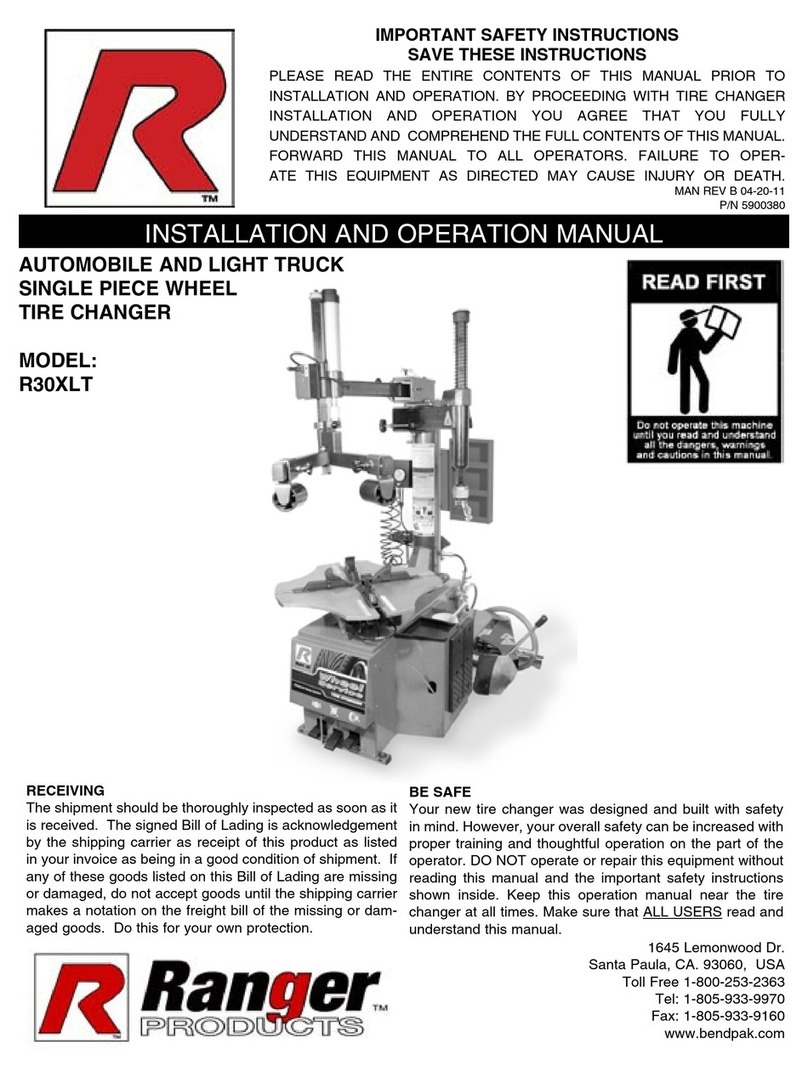
Ranger
Ranger R30XLT Installation and operation manual
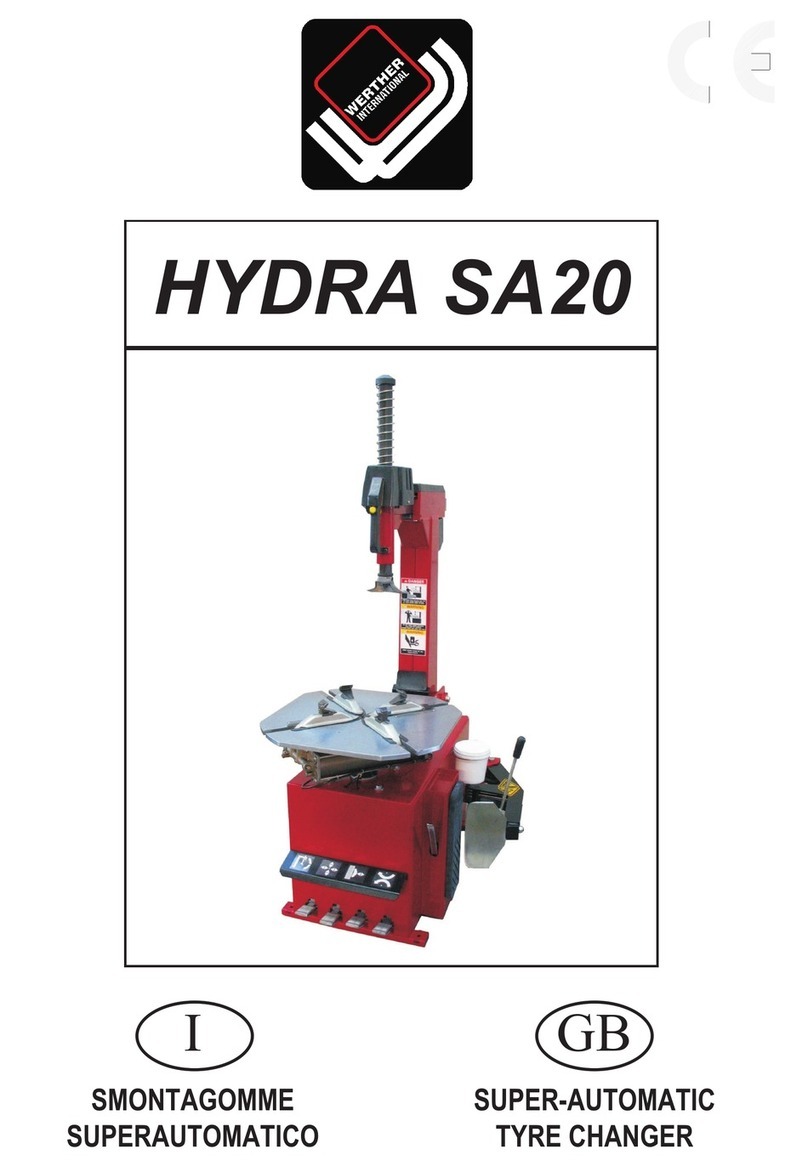
WERTHER INTERNATIONAL
WERTHER INTERNATIONAL HYDRA SA20 Instruction and maintenance manual
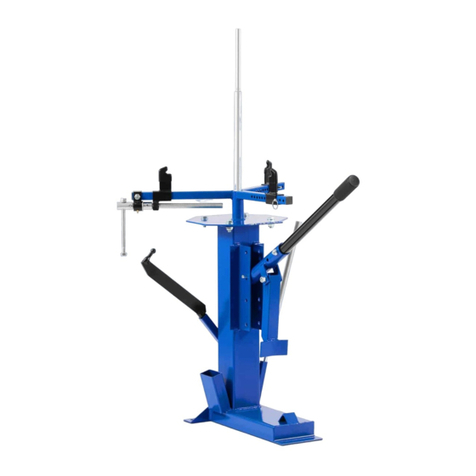
MSW Motor Technics
MSW Motor Technics MSW-MTC-350 user manual
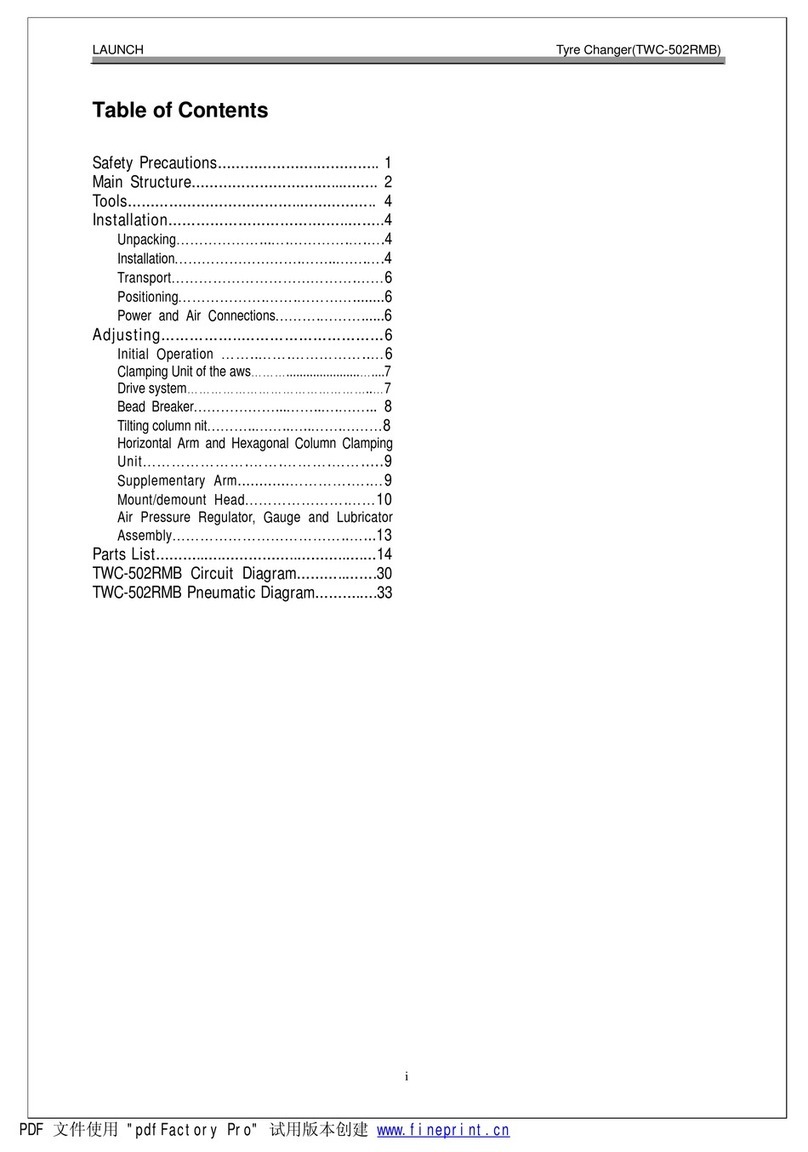
Launch
Launch TWC-502RMB manual
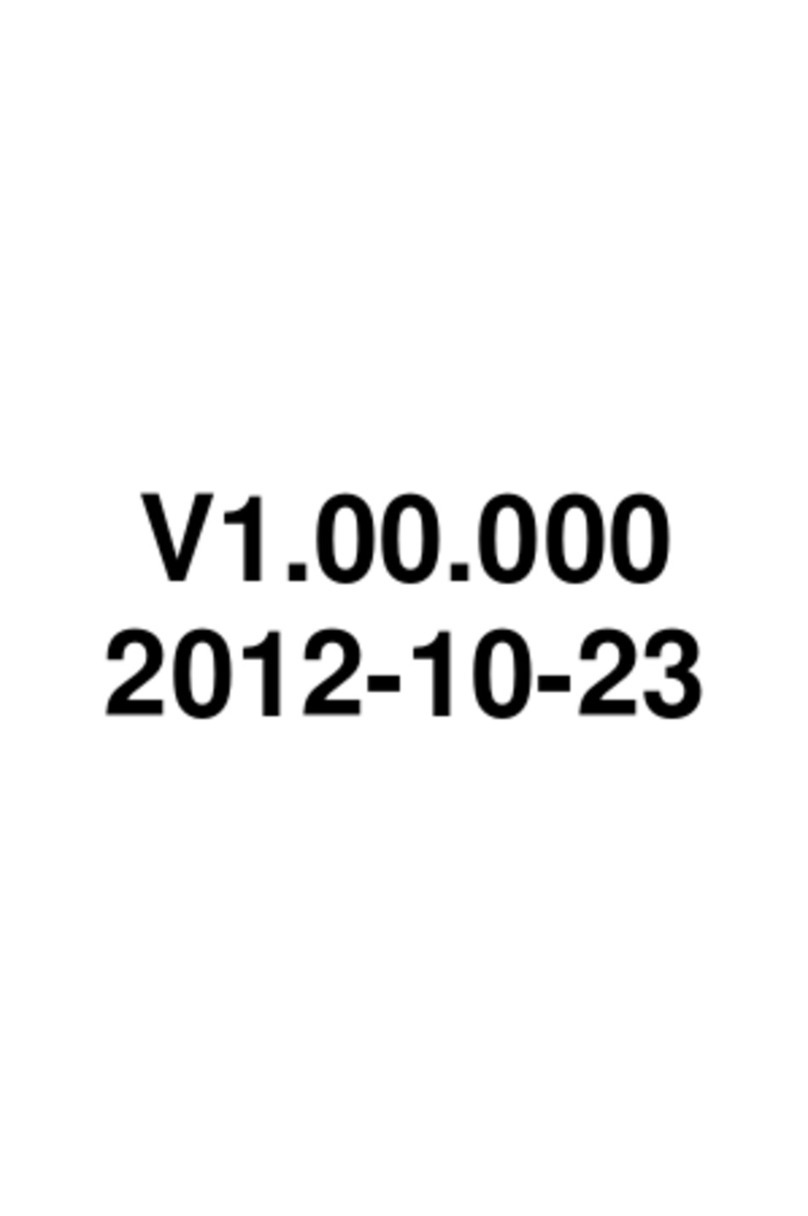
Launch
Launch TWC-711 manual
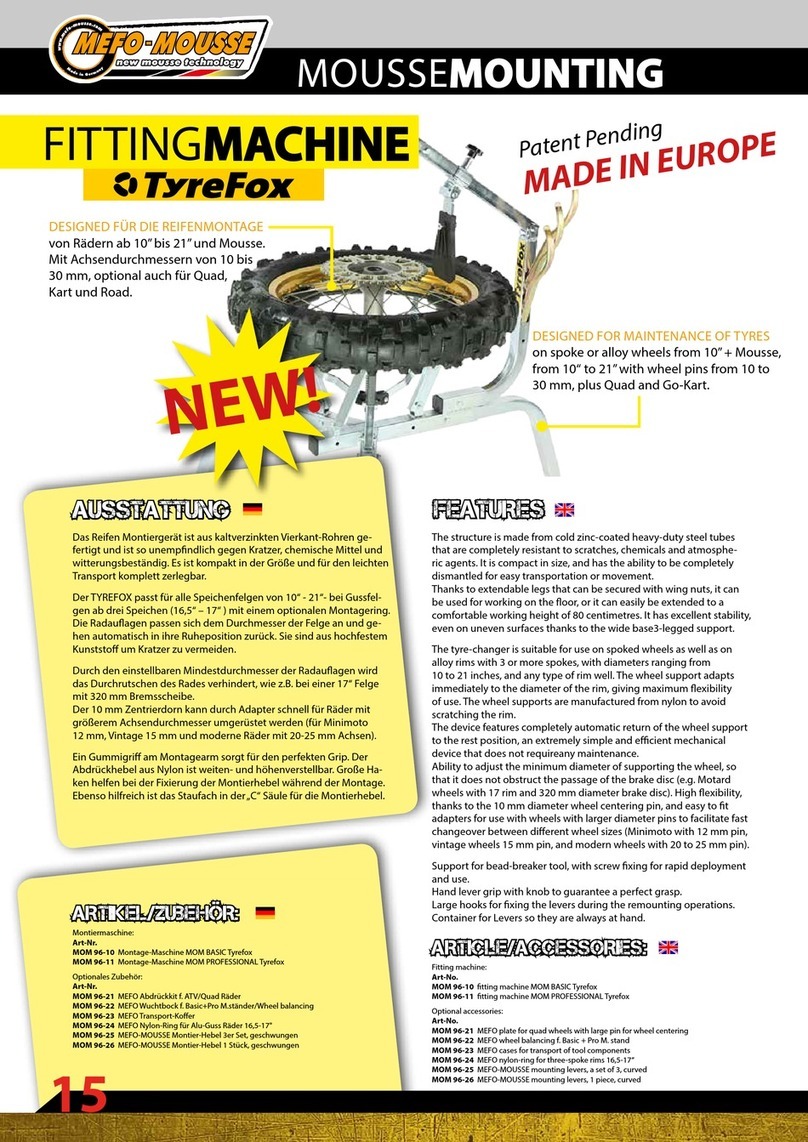
MEFO-MOUSSE
MEFO-MOUSSE MOM BASIC Tyrefox MOM 96-10 manual
